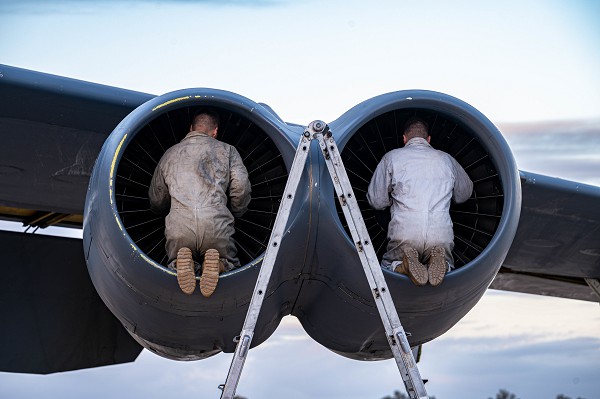
Moron Air Base, Spain. (March 17, 2023): In this photo by Airman 1st Class Alexander Nottingham, Air Force Staff Sergeant David Petrie (left) and Staff Sergeant Timothy Patterson (right) inspect the engine of an incoming B-52H Stratofortress after Bomber Task Force Operations. Both Sergeants are crew chiefs assigned to the 23rd Expeditionary Bomb Squadron, affectionately known as the “Bomber Barons”. They fly and maintain an aircraft that is older than some of their parents yet remains a vital component of America’s nuclear deterrence.
Based at Minot Air Force Base, North Dakota, the 23rd Bomb Squadron is one of the oldest in the United States Air Force, dating to 16 June 1917, and the unit deployed to England as part of the American Expeditionary Forces during World War I. The squadron saw combat during World War II and became part of the Strategic Air Command (SAC) during the Cold War.
Originally built during the 1960s, the B-52H Stratofortress is a long-range, heavy bomber that can perform a variety of missions. Flying at high subsonic speeds at altitudes of up to 50,000 feet, the Stratofortress can carry nuclear or precision guided conventional ordnance for precise delivery anywhere in the world. The B-52 can perform strategic attack, close-air support, air interdiction, offensive counter-air, and maritime operations.
The B-52 is highly effective when used for ocean surveillance by the U.S. Navy in anti-ship and mine-laying operations. In two hours, two B-52s can monitor 140,000 square miles (364,000 square kilometers) of ocean surface.
Today’s B-52 are equipped with advanced targeting pods for use in close air support of ground forces and it carries several “standoff” weapons, such as laser or GPS guided munitions, to destroy large targets. Aerial refueling gives the B-52 a range only limited by air crew endurance. Unrefueled, the B-52 still has a ranger of over 8,800 miles.
Flying out of Moron Air Base, the 321st mission is to familiarize its pilots and air crews with the facilities they would use when deploying overseas in a national emergency.


